Apply to Aakash iACST Scholarship Test 2024
NCERT Solutions for Class 12 Maths Chapter 8 Application of integrals
NCERT Application Of Integrals Class 12 Questions And Answers
NCERT Solutions for Class 12 Maths Chapter 8 Application of Integrals are discussed here. These NCERT solutions are created by expert team at Creers360 keeping in mind of latest syllabus of CBSE 2023-24. In geometry, you must have learned some formulas to calculate areas of simple geometrical figures like triangles, rectangles, trapeziums, circles, etc. But how do you calculate areas enclosed by curves? In this article, you will get NCERT solutions for class 12 maths chapter 8 application of integrals. This article also includes application of integrals class 12 solutions. Important topics that are going to be discussed in this chapter 8 class 12 maths are the area under simple curves, the area between lines and arcs of circles, parabolas, and ellipses. Interested students can find all NCERT Solutions for Class 12 Maths in one place
- NCERT Application Of Integrals Class 12 Questions And Answers
- NCERT Application Of Integrals Class 12 Questions And Answers PDF Free Download
- Application Of Integrals Class 12 NCERT Solutions - Important Formulae
- NCERT Application Of Integrals Class 12 Questions And Answers (Intext Questions and Exercise)
- Application of integrals class 12 - Topics
- NCERT solutions for class 12 maths - Chapter wise
- Key Features of NCERT Solutions for Class 12 Maths Chapter 8 Application of Integrals
- NCERT solutions for class 12 subject wise
- NCERT Solutions Class Wise
- NCERT Books and NCERT Syllabus
In the applications of integrals class 12 ncert solutions, questions from all these topics are covered. In this composition of Class 12 Maths Chapter 8 NCERT solutions application of integrals, you will learn some important applications of integrals class 12. If you are interested to check all NCERT solutions from classes 6 to 12 in a single place, which will help you to learn CBSE maths and science. Here you will get NCERT solutions for class 12.
Also read:
- Class 12 Maths Chapter 9 Applications of integrals Notes
- NCERT Exemplar Solutions for Class 12 Maths Chapter 8 Applications of Integrals
NCERT Application Of Integrals Class 12 Questions And Answers PDF Free Download
Application Of Integrals Class 12 NCERT Solutions - Important Formulae
>> Area Enclosed by a Curve and Lines: The area enclosed by the curve y = f(x), the x-axis, and the lines x = a and x = b (where b > a) is given by the formula:
Area = ∫[a, b]y.dx = ∫[a, b]f(x).dx
>> Area Bounded by Curve and Horizontal Lines: The area of the region bounded by the curve x = φ(y) as its y-axis and the lines y = c and y = d is given by the formula: Area = ∫[c, d]x.dy = ∫[c, d]φ(y).dy
>> Area Between Two Curves and Vertical Lines: The area enclosed between two given curves y = f(x) and y = g(x), and the lines x = a and x = b is given by the formula:
Area = ∫[a, b][f(x) - g(x)].dx (Where f(x) ≥ g(x) in [a, b])
>> Area Between Curves with Different Intervals: If f(x) ≥ g(x) in [a, c] and f(x) ≤ g(x) in [c, b], where a < c < b, then the resultant area between the curves is given as:
Area = ∫[a, c][f(x) - g(x)].dx + ∫[c, b][g(x) - f(x)].dx
Free download Application Of Integrals Class 12 NCERT Solutions for CBSE Exam.
NCERT Application Of Integrals Class 12 Questions And Answers (Intext Questions and Exercise)
NCERT class 12 maths chapter 8 question answer Exercise: 8.1
Question:1 Find the area of the region bounded by the curve and the lines
and the
-axis in the first quadrant.
Answer:
Area of the region bounded by the curve and the lines
and the
-axis in the first quadrant
Area =
= 14/3 units
Question:2 Find the area of the region bounded by and the
-axis in the first quadrant.
Answer:
Area of the region bounded by the curve and the
-axis in the first quadrant
Area =
units
Question:3 Find the area of the region bounded by and the
-axis in the first quadrant.
Answer:
The area bounded by the curves and the
-axis in the first quadrant is ABCD.

Question:4 Find the area of the region bounded by the ellipse
Answer:
The area bounded by the ellipse :

Area will be 4 times the area of EAB.
Therefore,
Therefore the area bounded by the ellipse will be
Question: 5 Find the area of the region bounded by the ellipse
Answer:
The area bounded by the ellipse :
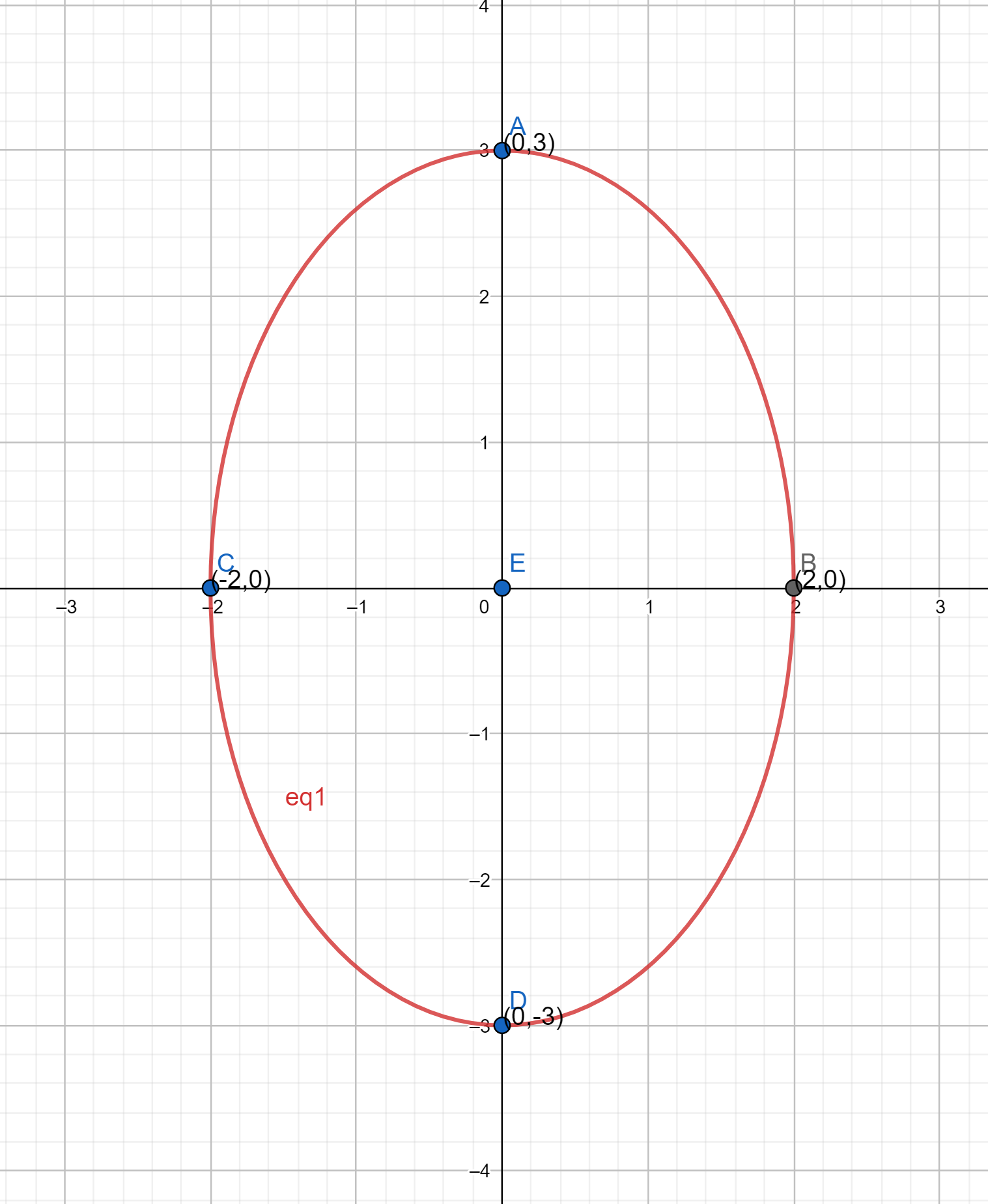
The area will be 4 times the area of EAB.
Therefore,
Therefore the area bounded by the ellipse will be
Question: 6 Find the area of the region in the first quadrant enclosed by -axis, line
and the circle
Answer:
The area of the region bounded by and
is ABC shown:
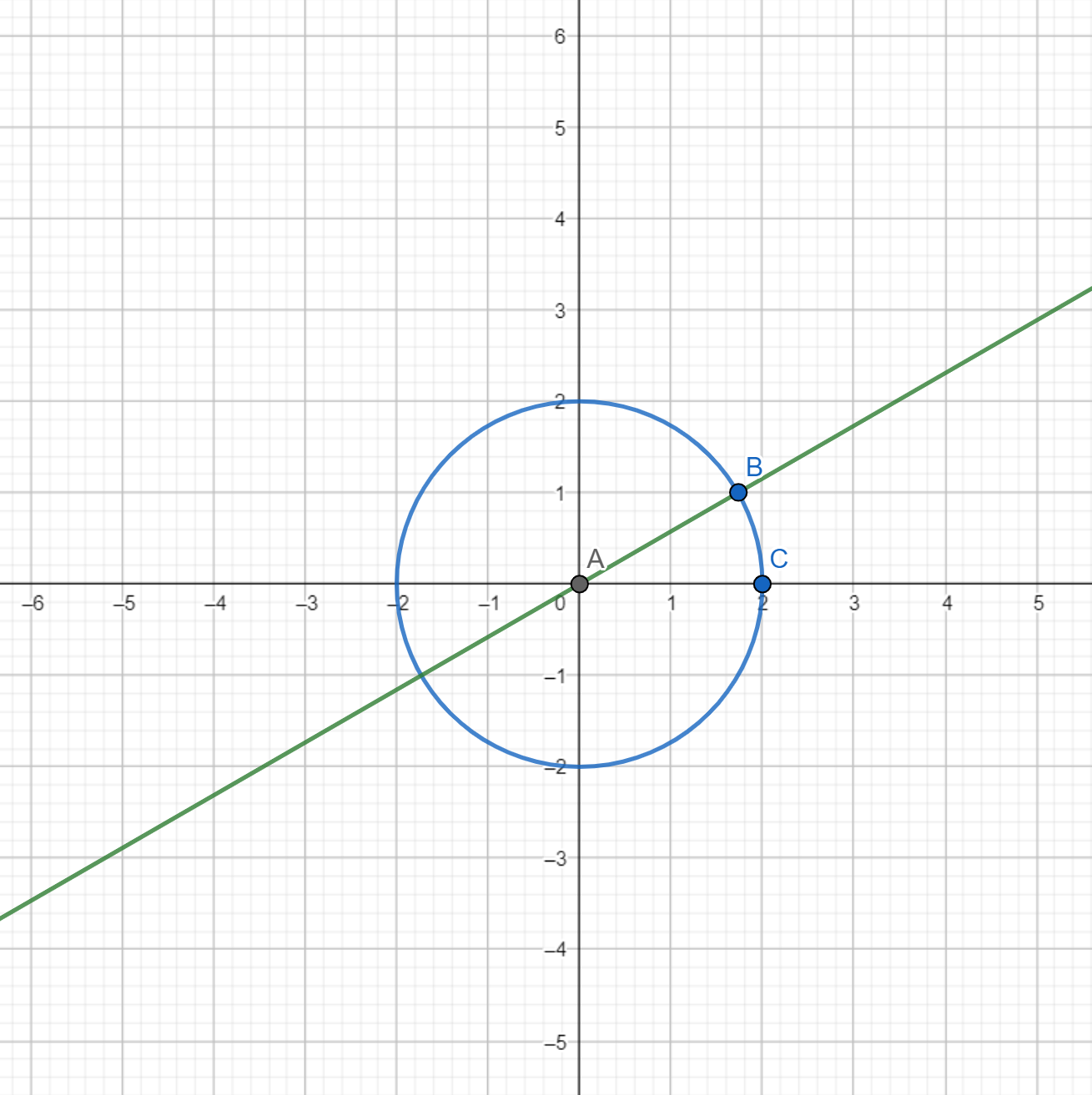
The point B of the intersection of the line and the circle in the first quadrant is .
Area ABC = Area ABM + Area BMC where, M is point in x-axis perpendicular drawn from the line.
Now,area of ............(1)
and Area of
..................................(2)
then adding the area (1) and (2), we have then
The Area under ABC
Question: 7 Find the area of the smaller part of the circle cut off by the line
Answer:
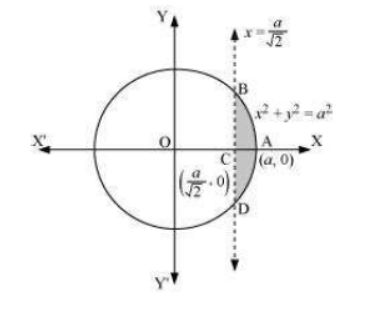
we need to find the area of smaller part of the circle
Now,
Area of ABCD = 2 X Area of ABC
Area of ABC =
Area of ABCD = 2 X Area of ABC
Therefore, the area of the smaller part of the circle is
Question:8 The area between and
is divided into two equal parts by the line
, find the value of
.
Answer:
 we can clearly see that given area is symmetrical about x - axis
we can clearly see that given area is symmetrical about x - axis
It is given that
Area of OED = Area of EFCD
Area of OED =
Area of EFCD =
Area of OED = Area of EFCD
Therefore, the value of a is
Question:9 Find the area of the region bounded by the parabola and
.
Answer:
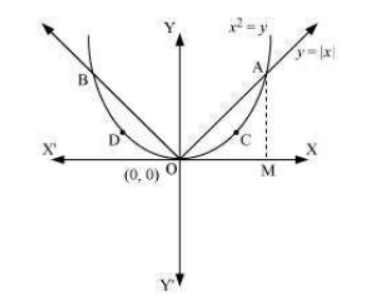 We can clearly see that given area is symmetrical about y-axis
We can clearly see that given area is symmetrical about y-axis
Therefore,
Area of OCAO = Area of OBDO
Point of intersection of is (1 , 1) and (-1 , 1)
Now,
Area od OCAO = Area OAM - Area of OCMO
Area of OAM =
Area of OCMO =
Therefore,
Area od OCAO
Now,
Area of the region bounded by the parabola and
is = 2 X Area od OCAO
Units
Question: 10 Find the area bounded by the curve and the line
.
Answer:
 Points of intersections of
Points of intersections of is
Now,
Area of OBAO = Area of OBCO + Area of OCAO
Area of OBCO = Area of OMBCO- Area of OMBO
Area of OMBCO =
Area of OMBO =
Area of OBCO = Area of OMBCO- Area of OMBO
Similarly,
Area of OCAO = Area of OCALO - Area of OALO
Area of OCALO =
Area of OALO =
Area of OCAO = Area of OCALO - Area of OALO
Now,
Area of OBAO = Area of OBCO + Area of OCAO
Therefore, area bounded by the curve and the line
is
Question: 11 Find the area of the region bounded by the curve and the line
.
Answer:
The combined figure of the curve and
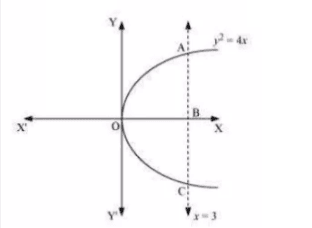
![]()
The required are is OABCO, and it is symmetrical about the horizontal axis.
Therefore, Area of OABCO = 2 Area of OAB
therefore the required area is units.
Question: 12 Choose the correct answer in the following
Area lying in the first quadrant and bounded by the circle and the lines
and
is
Answer:
The correct answer is A
The area bounded by circle C(0,0,4) and the line x=2 is 
![]()
The required area = area of OAB
Question: 13 Choose the correct answer in the following.
Area of the region bounded by the curve ,
-axis and the line
is
Answer:
The area bounded by the curve and y =3

![]()
the required area = OAB =
NCERT application of integrals class 12 solutions Exercise: 8.2
Question: 1 Find the area of the circle which is interior to the parabola
.
Answer:
The area bounded by the circle and the parabola
.
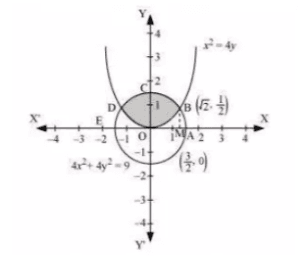
![]()
By solving the equation we get the intersecting point and
So, the required area (OBCDO)=2 times the area of (OBCO)
Draw a normal on the x-axis (M = )
Thus the area of OBCO = Area of OMBCO - Area of OMBO
S0, total area =
Question:2 Find the area bounded by curves and
.
Answer:
 Given curves are
Given curves are and
Point of intersection of these two curves are
and
We can clearly see that the required area is symmetrical about the x-axis
Therefore,
Area of OBCAO = 2 Area of OCAO
Now, join AB such that it intersects the x-axis at M and AM is perpendicular to OC
Coordinates of M =
Now,
Area OCAO = Area OMAO + Area CMAC
Now,
Area of OBCAO = 2 Area of OCAO
Therefore, the answer is
Question: 3 Find the area of the region bounded by the curves and
.
Answer:
The area of the region bounded by the curves,
and
is represented by the shaded area OCBAO as
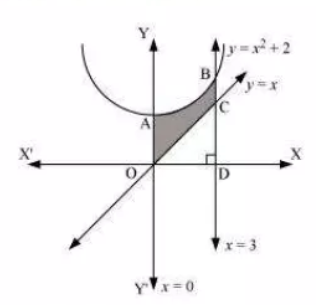
Then, Area OCBAO will be = Area of ODBAO - Area of ODCO
which is equal to
Question: 4 Using integration find the area of region bounded by the triangle whose vertices are and
.
Answer:
So, we draw BL and CM perpendicular to x-axis.
Then it can be observed in the following figure that,
We have the graph as follows:
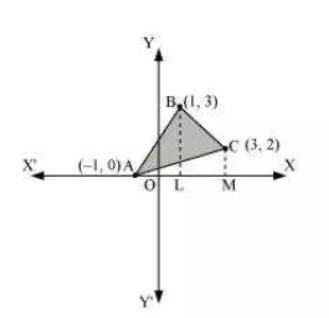
Equation of the line segment AB is:
or
Therefore we have Area of
So, the equation of line segment BC is
or
Therefore the area of BLMCB will be,
Equation of the line segment AC is,
or
Therefore the area of AMCA will be,
Therefore, from equations (1), we get
The area of the triangle
Question:5 Using integration find the area of the triangular region whose sides have the equations and
.
Answer:
The equations of sides of the triangle are .
ON solving these equations, we will get the vertices of the triangle as

Thus it can be seen that,
Question:6 Choose the correct answer.
Smaller area enclosed by the circle and the line
is
Answer:
So, the smaller area enclosed by the circle, , and the line,
, is represented by the shaded area ACBA as

Thus it can be observed that,
Area of ACBA = Area OACBO - Area of
Thus, the correct answer is B.
Question:7 Choose the correct answer.
Area lying between the curves and
is
Answer:
The area lying between the curve, and
is represented by the shaded area OBAO as
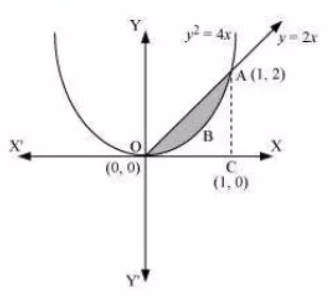
The points of intersection of these curves are and
.
So, we draw AC perpendicular to x-axis such that the coordinates of C are (1,0).
Therefore the Area OBAO =
Thus the correct answer is B.
NCERT application of integrals class 12 solutions Miscellaneous: Exercise
Question:1 Find the area under the given curves and given lines:
Answer:
The area bounded by the curve and
-axis
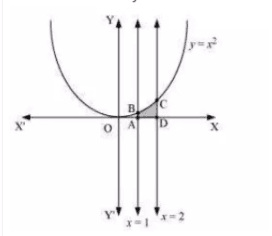
![]()
The area of the required region = area of ABCD
Hence the area of shaded region is 7/3 units
Question:1 Find the area under the given curves and given lines:
Answer:
The area bounded by the curev and
-axis
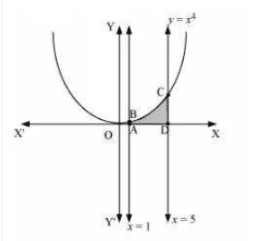
![]()
The area of the required region = area of ABCD
Hence the area of the shaded region is 624.8 units
Question:2 Find the area between the curves and
.
Answer:
the area between the curves and
.
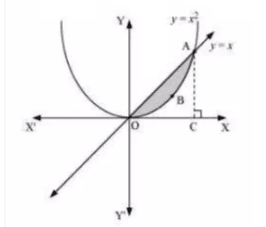
![]()
The curves intersect at A(1,1)
Draw a normal to AC to OC(x-axis)
therefore, the required area (OBAO)= area of (OCAO) - area of (OCABO)
Thus the area of shaded region is 1/6 units
Question:3 Find the area of the region lying in the first quadrant and bounded by and
.
Answer:
the area of the region lying in the first quadrant and bounded by and
.
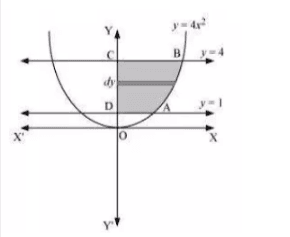
![]()
The required area (ABCD) =
The area of the shaded region is 7/3 units
Question:4 Sketch the graph of and evaluate
Answer:
y=|x+3|
the given modulus function can be written as
x+3>0
x>-3
for x>-3
y=|x+3|=x+3
x+3<0
x<-3
For x<-3
y=|x+3|=-(x+3)
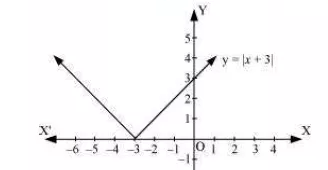
Integral to be evaluated is
Question:5 Find the area bounded by the curve between
and
.
Answer:
The graph of y=sinx is as follows
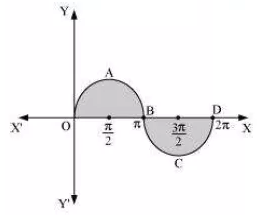
We need to find the area of the shaded region
ar(OAB)+ar(BCD)
=2ar(OAB)
The bounded area is 4 units.
Question:6 Find the area enclosed between the parabola and the line
.
Answer:
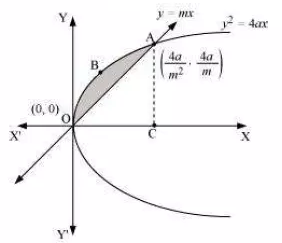
We have to find the area of the shaded region OBA
The curves y=mx and y 2 =4ax intersect at the following points
The required area is
Question:7 Find the area enclosed by the parabola and the line
.
Answer:

We have to find the area of the shaded region COB
The two curves intersect at points (2,3) and (4,12)
Required area is
Question:8 Find the area of the smaller region bounded by the ellipse and the line
.
Answer:
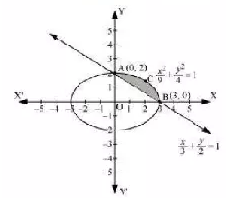
We have to find the area of the shaded region
The given ellipse and the given line intersect at following points
Since the shaded region lies above x axis we take y to be positive
The required area is
Question:9 Find the area of the smaller region bounded by the ellipse and the line
.
Answer:
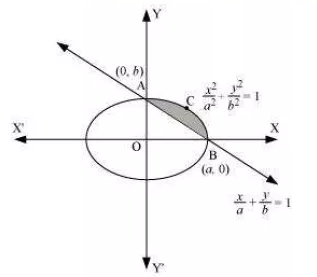
The area of the shaded region ACB is to be found
The given ellipse and the line intersect at following points
Y will always be positive since the shaded region lies above x axis
The required area is
Question:10 Find the area of the region enclosed by the parabola the line
and the
-axis.
Answer:

We have to find the area of the shaded region BAOB
O is(0,0)
The line and the parabola intersect in the second quadrant at (-1,1)
The line y=x+2 intersects the x axis at (-2,0)
The area of the region enclosed by the parabola the line
and the
-axis is 5/6 units.
Question:11 Using the method of integration find the area bounded by the curve
[ Hint: The required region is bounded by lines and
]
Answer:
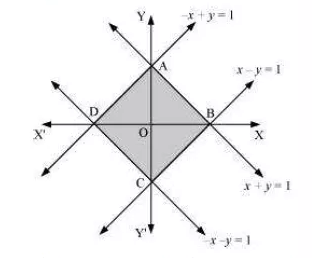
We need to find the area of the shaded region ABCD
ar(ABCD)=4ar(AOB)
Coordinates of points A and B are (0,1) and (1,0)
Equation of line through A and B is y=1-x
The area bounded by the curve is 2 units.
Question:12 Find the area bounded by curves .
Answer:
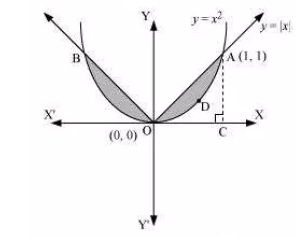
We have to find the area of the shaded region
In the first quadrant
y=|x|=x
Area of the shaded region=2ar(OADO)
The area bounded by the curves is 1/3 units.
Question:13 Using the method of integration find the area of the triangle ABC, coordinates of whose vertices are
Answer:
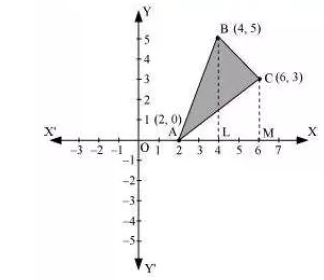
Equation of line joining A and B is
Equation of line joining B and C is
Equation of line joining A and C is
ar(ABC)=ar(ABL)+ar(LBCM)-ar(ACM)
ar(ABC)=8+5-6=7
Therefore the area of the triangle ABC is 7 units.
Question:14 Using the method of integration find the area of the region bounded by lines:
Answer:
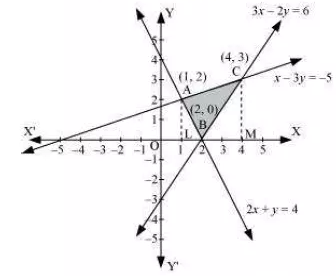
We have to find the area of the shaded region ABC
ar(ABC)=ar(ACLM)-ar(ALB)-ar(BMC)
The lines intersect at points (1,2), (4,3) and (2,0)
Area of the region bounded by the lines is 3.5 units
Question:15 Find the area of the region .
Answer:

We have to find the area of the shaded region OCBAO
Ar(OCBAO)=2ar(OCBO)
For the fist quadrant
In the first quadrant, the curves intersect at a point
Area of the unshaded region in the first quadrant is
The total area of the shaded region is-
= Area of half circle - area of the shaded region in the first quadrant
Question:16 Choose the correct answer.
Area bounded by the curve , the
-axis and the ordinates
and
is
Answer:
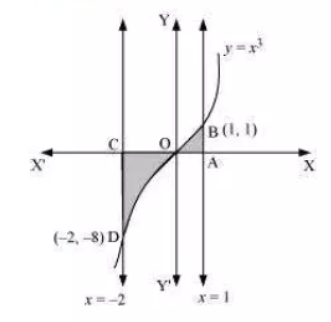
Hence the required area
Therefore the correct answer is B.
Question:17 Choose the correct answer.
T he area bounded by the curve ,
-axis and the ordinates
and
is given by
Answer:
The required area is
Question:18 Choose the correct answer.
The area of the circle exterior to the parabola
is
Answer:
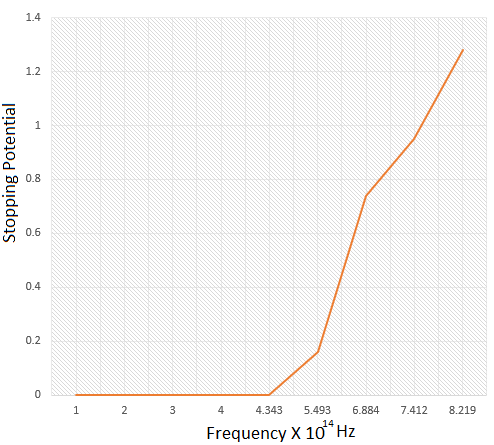
The area of the shaded region is to be found.
Required area =ar(DOC)+ar(DOA)
The region to the left of the y-axis is half of the circle with radius 4 units and centre origin.
Area of the shaded region to the left of y axis is ar(1) =
For the region to the right of y-axis and above x axis
The parabola and the circle in the first quadrant intersect at point
Remaining area is 2ar(2) is
Total area of shaded region is
Question:19 Choose the correct answer The area bounded by the -axis,
and
when
is
Answer:
Given : and

Area of shaded region = area of BCDB + are of ADCA
Hence, the correct answer is B.
If you are looking for exercises solutions for chapter application of integrals class 12 then these are listed below.
- Applications Of Integrals Class 12 Exercise 8.1
- Applications Of Integrals Class 12 Exercise 8.2
- Application Of Integrals Class 12 Miscellaneous Exercise
More about NCERT Solutions for Class 12 Maths chapter 8
Generally, one question (5 marks) is asked from this ch 8 maths class 12 in the 12th board final exam and you can score these 5 marks very easily with help of these NCERT solutions for class 12 maths chapter 8 application of integrals. In this chapter 8 class 12 maths, there are 2 exercises with 20 questions. In the NCERT class 12 maths ch 8 question answer, these questions are prepared and explained in a detailed manner using diagrams.
There are a total of 14 solved examples are given in the NCERT textbook to give a better understanding of the concepts related to the application of integrals class 12. Applications of integrals class 12 are indispensable for the Board exam. At the end of the chapter, 19 questions are given in a miscellaneous exercise. In the NCERT solutions for class 12 maths chapter 8 application of integrals article, you will get solutions to miscellaneous exercises too.
Application of integrals class 12 - Topics
8.1 Introduction
8.2 Area under Simple Curves
8.2.1 The area of the region bounded by a curve and a line
8.3 Area between Two Curves
Also read,
- NCERT Exemplar Class 12 Chemistry Solutions
- NCERT Exemplar Class 12 Mathematics Solutions
- NCERT Exemplar Class 12 Biology Solutions
- NCERT Exemplar Class 12 Physics Solutions
SAT® | CollegeBoard
Registeration closing on 19th Apr for SAT® | One Test-Many Universities | 90% discount on registrations fee | Free Practice | Multiple Attempts | no penalty for guessing
TOEFL ® Registrations 2024
Thinking of Studying Abroad? Think the TOEFL® test. Save 10% on your TOEFL exam with ApplyShop gift cards!
Let's understand these topics with help of examples
- How to find the area under simple curves- To find the area bounded by the curve
 and the ordinates
and the ordinates  and
and  . Let assume that area under the curve as composed of large numbers of very thin vertical strips. Consider an arbitrary strip of width dx and height y ,then area of the elementary strip(dA) = ydx , where, y = f(x). This small area called the elementary area.
. Let assume that area under the curve as composed of large numbers of very thin vertical strips. Consider an arbitrary strip of width dx and height y ,then area of the elementary strip(dA) = ydx , where, y = f(x). This small area called the elementary area.

- How to find the area of the region bounded by a curve and a line- In this subsection, we will find the area of the region bounded by a line and a circle, a line and an ellipse, a line and a parabola. Equations of the above-said curves will be in their standard forms only.
NCERT solutions for class 12 maths - Chapter wise
Key Features of NCERT Solutions for Class 12 Maths Chapter 8 Application of Integrals
The application of integrals class 12 ncert solutions offers several key features, including
Expertly crafted by knowledgeable subject specialists.
Designed to enhance students' fundamental understanding of the applications of integrals.
Clear and organized material.
All questions are answered using informative diagrams.
Supports students in completing their assignments and preparing for competitive exams.
NCERT solutions for class 12 subject wise
- NCERT solutions for class 12 mathematics
- NCERT solutions class 12 chemistry
- NCERT solutions for class 12 physics
- NCERT solutions for class 12 biology
NCERT Solutions Class Wise
- NCERT solutions for class 12
- NCERT solutions for class 11
- NCERT solutions for class 10
- NCERT solutions for class 9
Benefits of NCERT solutions:
- These NCERT maths chapter 8 class 12 solutions are very easy to understand as they are explained and are prepared in a detailed manner.
- Scoring good marks in the 12th board exam is now a reality with the help of these solutions of NCERT for class 12 maths chapter 8 application of integrals.
- NCERT solutions for Class 12 Maths Chapter 8 PDF download provides in-depth knowledge of the concepts as well as different ways to solve the problems.
- NCERT maths chapter 8 class 12 solutions are prepared by experts who know how to answer to score well in the board exam.
- You will also get some short tricks to check whether the answer is correct or not.
NCERT Books and NCERT Syllabus
Happy Reading !!!
Frequently Asked Question (FAQs)
Generally, one question of 5 marks is asked from this chapter in the 12th board final exam but if you want to obtain the full 5 five marks that demands practice, good strategy, and command of concepts, and therefore NCERT textbooks, NCERT syllabus becomes very important. it is advised for students to precisely go through the basics of class 12 maths chapter 8 question answer to score good marks.
Only knowing the answer is not enough to score good marks in the exam. One should know how to write the answer to board exam in order to get good marks. NCERT solutions are provided by experts who knows how best to write the answer in the board exam in order to get good marks. Practice class 12 maths chapter 8 question answer to command the concepts.
The NCERT Solutions for the application of integration class 12 at Careers360 are created by a team of experts through extensive research on each concept. The solutions are presented in a thorough and comprehensive manner, enabling students to perform well on class exams and board exams. Additionally, the solutions aid students in completing their assignments efficiently and on time. Interested students can download the application of integrals class 12 pdf.
Here you will get the detailed and comprehensive NCERT Solutions for class 12 maths by clicking on the link. if you want to study other material like NCERT Syllabus, NCERT Notes, NCERT Exercise Solutions, etc then you can browse the careers360 official website.
Some applications of integrals like finding area under simple curves, area of the region bounded by a curve and a line, and area between two curves are the important topics covered in this chapter. practice class 12 maths chapter 8 ncert solutions to score well in the exam.
The class 12 application of integrals ncert solutions can be challenging as it incorporates numerous formulas and intricate concepts. To gain a solid understanding of each topic, students must regularly test their mathematical skills by practicing the questions provided. With consistent revision and diligent effort, students can confidently ace any exam, be it for their board exams or in a competitive setting.
Also Read
Articles
Certifications By Top Providers
Explore Top Universities Across Globe
Questions related to CBSE Class 12th
Hello aspirant,
The purpose of graphic design extends beyond the brand's look. Nevertheless, by conveying what the brand stands for, it significantly aids in the development of a sense of understanding between a company and its audience. The future in the field of graphic designing is very promising.
There are various courses available for graphic designing. To know more information about these courses and much more details, you can visit our website by clicking on the link given below.
https://www.careers360.com/courses/graphic-designing-course
Thank you
Hope this information helps you.
hello,
Yes you can appear for the compartment paper again since CBSE gives three chances to a candidate to clear his/her exams so you still have two more attempts. However, you can appear for your improvement paper for all subjects but you cannot appear for the ones in which you have failed.
I hope this was helpful!
Good Luck
Hello dear,
If you was not able to clear 1st compartment and now you giving second compartment so YES, you can go for your improvement exam next year but if a student receives an improvement, they are given the opportunity to retake the boards as a private candidate the following year, but there are some requirements. First, the student must pass all of their subjects; if they received a compartment in any subject, they must then pass the compartment exam before being eligible for the improvement.
As you can registered yourself as private candidate for giving your improvement exam of 12 standard CBSE(Central Board of Secondary Education).For that you have to wait for a whole year which is bit difficult for you.
Positive side of waiting for whole year is you have a whole year to preparing yourself for your examination. You have no distraction or something which may causes your failure in the exams. In whole year you have to stay focused on your 12 standard examination for doing well in it. By this you get a highest marks as a comparison of others.
Believe in Yourself! You can make anything happen
All the very best.
Hello Student,
I appreciate your Interest in education. See the improvement is not restricted to one subject or multiple subjects and we cannot say if improvement in one subject in one year leads to improvement in more subjects in coming year.
You just need to have a revision of all subjects what you have completed in the school. have a revision and practice of subjects and concepts helps you better.
All the best.
Hi,
You just need to give the exams for the concerned two subjects in which you have got RT. There is no need to give exam for all of your subjects, you can just fill the form for the two subjects only.
Popular CBSE Class 12th Questions
Colleges After 12th
Also Read
Applications for Admissions are open.

JEE Main Important Physics formulas
ApplyAs per latest 2024 syllabus. Physics formulas, equations, & laws of class 11 & 12th chapters

UPES School of Liberal Studies
ApplyRanked #52 Among Universities in India by NIRF | Up to 30% Merit-based Scholarships | Lifetime placement assistance

Aakash iACST Scholarship Test 2024
ApplyGet up to 90% scholarship on NEET, JEE & Foundation courses

JEE Main Important Chemistry formulas
ApplyAs per latest 2024 syllabus. Chemistry formulas, equations, & laws of class 11 & 12th chapters

PACE IIT & Medical, Financial District, Hyd
ApplyEnrol in PACE IIT & Medical, Financial District, Hyd for JEE/NEET preparation

ALLEN JEE Exam Prep
ApplyStart your JEE preparation with ALLEN
